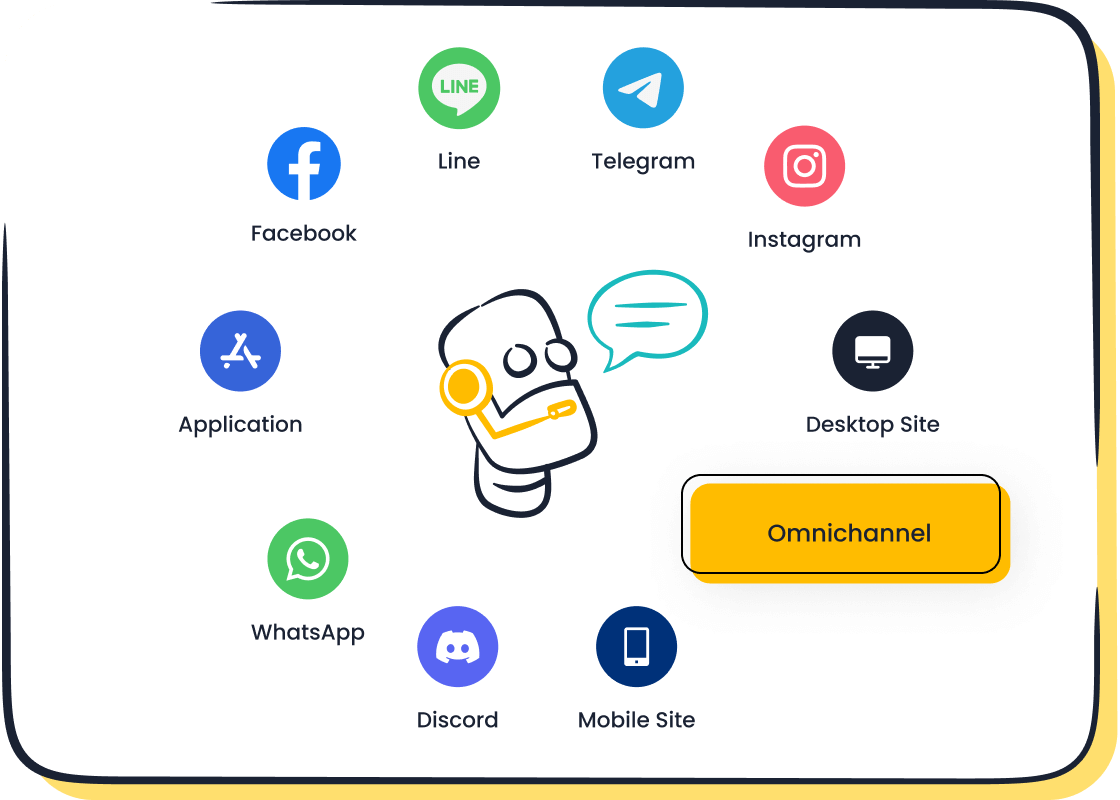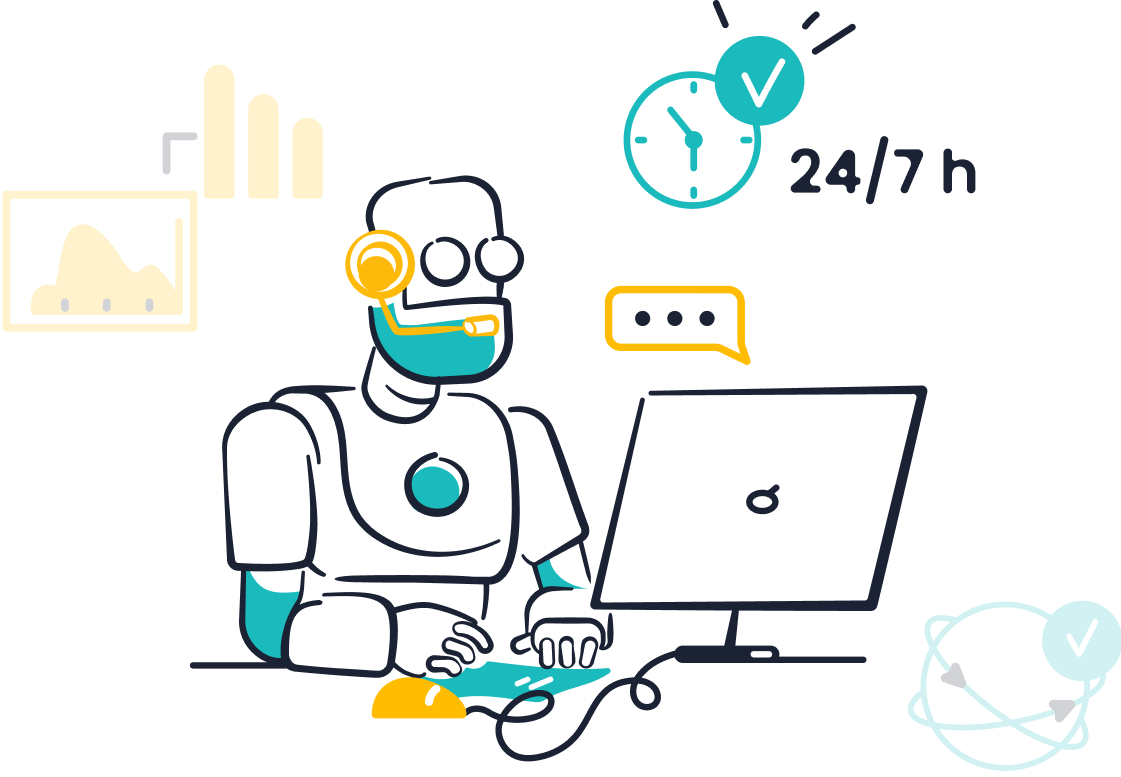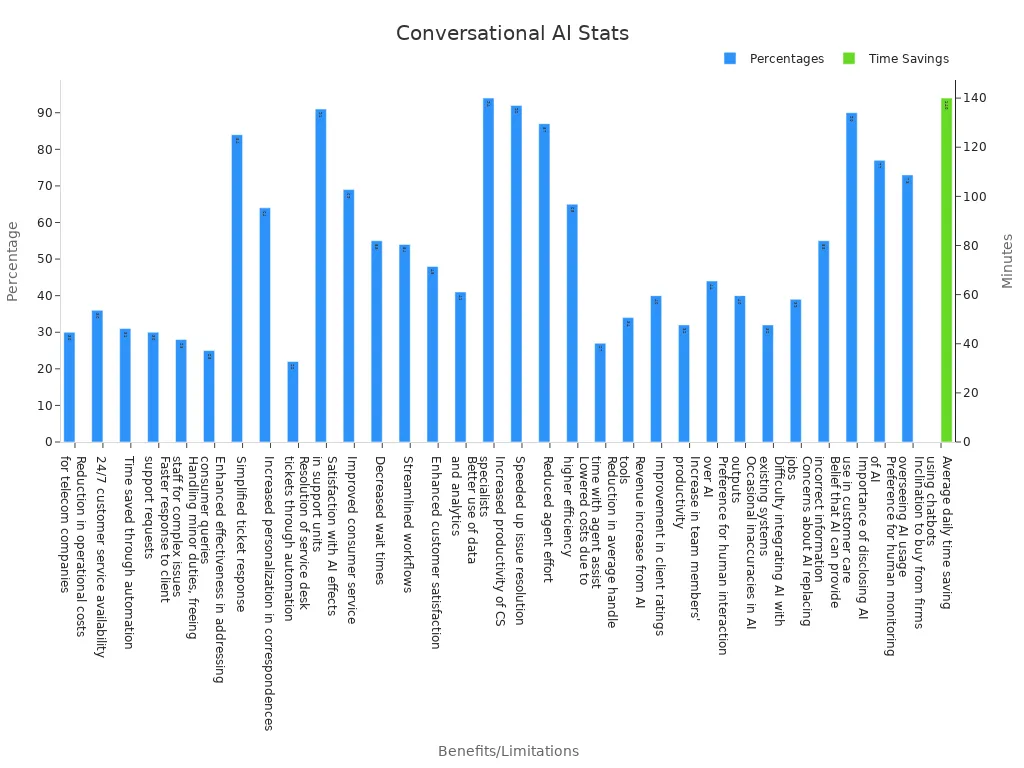Which AI Fits Your Needs: Conversational or Generative

Artificial Intelligence (AI) has transformed how businesses operate, but not all AI serves the same purpose. Conversational AI focuses on enabling seamless, human-like communication. It uses technologies like natural language understanding to respond to queries and hold coherent dialogues. On the other hand, generative AI creates original content, such as text, images, or videos, by learning from existing data.
You can see these technologies shine in their respective fields. Conversational AI improves customer experience in industries like retail and gaming by guiding users through queries or website navigation. Generative AI, however, excels in creative tasks like generating blogs or visual art. This raises an important question: conversational AI vs. generative AI—which one aligns better with your business goals? Solutions like Sobot can help you decide based on your needs.
Understanding Conversational AI

Definition and Core Features
Conversational AI refers to technology that enables machines to interact with humans in natural, human-like ways. It uses advanced tools like natural language processing (NLP) to understand user input, recognize intent, and provide meaningful responses. This technology powers chatbots, virtual assistants, and voice interfaces, making them capable of holding contextual and scalable conversations.
Key features of conversational AI include:
- Natural Language Processing (NLP): Helps analyze and interpret user queries.
- Workflow Automation: Streamlines repetitive tasks, reducing human involvement.
- Personalized Recommendations: Offers tailored suggestions based on user behavior.
- Transaction Support: Handles secure and complex actions like payments or bookings.
- Scalability: Manages thousands of interactions simultaneously without losing context.
These features make conversational AI a powerful tool for improving customer engagement and operational efficiency.
Applications in Customer Service and Contact Centers
Conversational AI has revolutionized customer support by automating routine tasks and enhancing user experiences. Businesses across industries like retail, healthcare, and banking use AI chatbots to provide 24/7 assistance, reduce costs, and improve response times. For example, AI chatbots can handle up to 80% of routine inquiries, freeing human agents to focus on complex issues.
The adoption of conversational AI in customer service is growing rapidly. By 2025, 95% of all customer interactions will involve AI-powered tools, according to AI Business. Companies also report significant cost savings and improved customer satisfaction. For instance, businesses like Lyft have reduced resolution times by 87% using AI-driven solutions.

Sobot AI Chatbot: A Conversational AI Solution
The Sobot AI Chatbot is a leading conversational AI solution designed to transform customer engagement. It automates interactions, solves routine queries, and assists agents, improving productivity by 70%. Operating 24/7, it reduces costs by up to 50% while boosting conversions by 20%.
This AI chatbot supports multiple languages and integrates seamlessly with platforms like WhatsApp and SMS. Its no-code setup allows you to deploy it effortlessly, making it accessible for businesses of all sizes. With features like omnichannel support and real-time intent recognition, the Sobot AI Chatbot ensures efficient and personalized customer support.
For example, OPPO, a global smartphone leader, achieved an 83% chatbot resolution rate and a 57% increase in repurchase rates by implementing Sobot's chatbot. This success highlights how conversational AI can enhance customer satisfaction and drive business growth.
Exploring Generative AI
Definition and Core Features
Generative AI is a specialized branch of artificial intelligence that creates new content by learning from extensive datasets. Unlike traditional AI, which follows predefined rules, generative AI adapts to various environments and generates outputs that mimic the complexity of its training data. This adaptability makes it a powerful tool for businesses seeking innovative solutions.
Key features of generative AI include:
- Creativity: It reimagines information to produce original content, such as text, images, or videos.
- Scalability: It handles large-scale operations efficiently, maintaining performance as data volumes grow.
- Human Capability Enhancement: It automates complex tasks, inspiring new ideas and increasing productivity.
For example, companies integrating generative AI into their operations have seen a 9% increase in corporate value. By 2030, this technology is expected to contribute $15.7 trillion to the global economy, showcasing its transformative potential.
Use Cases in Content Creation and Innovation
Generative AI excels in content creation and innovation, making it a valuable asset for businesses. It can generate personalized content tailored to your audience, improving engagement and satisfaction. For instance, Hearst Newspapers used generative AI to produce creative drafts and ideas, enabling faster content cycles and reducing operational costs.
This technology also supports innovation by automating repetitive tasks, allowing your team to focus on strategic goals. In marketing, 34% of companies already use generative AI to create targeted campaigns. Its ability to scale production while maintaining quality makes it ideal for industries like media, retail, and e-commerce.
| Aspect | Details |
|---|---|
| Company | Hearst Newspapers |
| Challenge | Rapidly producing diverse and creative content for multiple platforms while maintaining quality. |
| Solution | Implemented a Generative AI tool to support content creators, generating drafts and ideas. |
| Increased Production | Enabled faster content creation cycles for more frequent updates. |
| Enhanced Creativity | AI-generated ideas served as a base for further refinement, boosting creativity. |
| Cost Efficiency | Reduced need for large teams, lowering operational costs while maintaining quality. |
Generative AI in Enhancing Customer Interactions
Generative AI transforms customer interactions by providing dynamic, personalized content and real-time solutions. For example, it updates FAQ sections based on incoming queries, ensuring customers always have access to accurate information. This reduces the workload on your customer service team and improves satisfaction.
Additionally, generative AI performs sentiment analysis on customer interactions. It identifies emotions and feedback, helping you refine your strategies to build loyalty. A telecom provider used generative AI to diagnose connectivity issues through targeted questions, resolving problems quickly and boosting customer satisfaction.
Tip: Generative AI can automate up to 30% of work hours by 2030, making it a game-changer for industries focused on customer experience.
Conversational AI vs. Generative AI: Key Differences

Purpose and Use Cases
The primary difference between conversational AI and generative AI lies in their purpose. Conversational AI focuses on enabling human-like interactions. It is designed to understand user inputs and provide meaningful responses. This makes it ideal for customer service, where it can handle inquiries, guide users, and even complete transactions. For example, 70% of APAC organizations plan to increase spending on conversational commerce solutions, highlighting its growing importance in customer support.
Generative AI, on the other hand, aims to create new and unique content. It excels in tasks like generating marketing copy, designing visuals, or even composing music. Businesses often use generative AI to produce personalized content for campaigns, enhancing engagement and creativity. For instance, Hearst Newspapers leveraged generative AI to streamline content creation, reducing costs while maintaining quality.
| Purpose | Conversational AI | Generative AI |
|---|---|---|
| Focus | Interacting in human-like conversations | Creating new and unique content |
| Use Cases | Customer support and service | Generating new content for marketing |
Language Understanding and Interaction Styles
Conversational AI and generative AI differ significantly in how they understand and interact with language. Conversational AI relies on natural language processing (NLP) to interpret user queries and respond contextually. It excels in maintaining coherent dialogues, making it suitable for applications like chatbots and virtual assistants. For example, the Sobot AI Chatbot uses NLP to provide accurate, real-time responses across multiple channels, ensuring seamless customer interactions.
Generative AI, powered by large language models (LLMs), takes language understanding to another level. It not only processes queries but also generates creative and dynamic responses. LLMs enhance interaction styles by being flexible, patient, and capable of refining their outputs. They encourage curiosity by personalizing responses and suggesting follow-ups. This makes generative AI an excellent tool for fostering engagement and innovation.
- Large language models support varied interaction styles, making them effective learning companions.
- They promote deeper questioning by creating a low-stakes environment for experimentation.
- Algorithmic response suggestions improve communication speed and emotional tone.
Training Methods and Data Utilization
The training methods and data utilization of conversational AI and generative AI are tailored to their specific goals. Conversational AI uses dialogue management algorithms and NLP to maintain coherent conversations. It focuses on context-aware responses, ensuring that interactions feel natural and relevant. For example, the Sobot AI Chatbot leverages a knowledge base built from articles and FAQs to provide accurate answers.
Generative AI employs advanced models like Variational Autoencoders (VAEs) and Generative Adversarial Networks (GANs). These models generate synthetic data to enhance performance and diversity. Unlike conversational AI, generative AI aims to create entirely new data points, mimicking the complexity of its training datasets.
| Aspect | Conversational AI | Generative AI |
|---|---|---|
| Training Methods | Utilizes dialogue management algorithms and natural language processing. | Employs models like Variational Autoencoders (VAEs) and Generative Adversarial Networks (GANs). |
| Data Utilization | Focuses on maintaining coherent conversations through context-aware responses. | Generates synthetic data for augmentation and enhances model performance through data diversity. |
| Purpose | Aims to understand and respond to user inputs in a human-like manner. | Aims to create new, high-quality data points that resemble original data. |
AI training methods also vary in their reliance on data. Supervised learning uses labeled datasets, while unsupervised learning identifies patterns in unlabeled data. Deep learning further advances these methods by recognizing complex patterns in large datasets. However, sourcing and labeling data remain challenges for both conversational and generative AI.
- Supervised learning involves training with labeled data.
- Unsupervised learning uses unlabeled data for pattern recognition.
- Deep learning improves adaptability by identifying patterns in extensive datasets.
Input and Output Characteristics
When choosing between Conversational AI and Generative AI, understanding their input and output characteristics can help you make an informed decision. These characteristics define how each type of AI processes data and delivers results, shaping their suitability for different tasks.
Input Data
Conversational AI primarily works with text and audio inputs. For example, when you type a question into a chatbot or speak to a virtual assistant, the system processes your words to understand your intent. This makes it ideal for applications like customer service, where users interact through messages or voice commands.
Generative AI, on the other hand, handles a broader range of inputs. It can process text, images, audio, video, and even numerical data. This versatility allows it to create diverse outputs, such as generating marketing visuals or composing music. For instance, a retailer might use generative AI to design product advertisements based on customer preferences.
Output Format
The outputs of Conversational AI are straightforward. It generates responses in text or audio formats, ensuring clear and direct communication. For example, the Sobot AI Chatbot provides instant replies to customer queries, whether through a live chat window or a voice interface. This simplicity makes it effective for resolving customer issues quickly.
Generative AI, however, produces more complex outputs. It creates entirely new content across various formats, including articles, videos, and even 3D models. This capability makes it a powerful tool for businesses looking to innovate. For example, a gaming company could use generative AI to design unique characters or storylines, enhancing user engagement.
Comparison Table
Here’s a side-by-side comparison to help you visualize the differences:
| Characteristic | Conversational AI | Generative AI |
|---|---|---|
| Input Data | Text and audio | Text, images, audio, video, and numerical inputs |
| Output Format | Text and audio responses | Fresh content in various formats |
| Training Techniques | Supervised and reinforcement learning | Optimization algorithms and hyperparameter tuning |
| Evaluation Metrics | BLEU, ROUGE scores, user satisfaction surveys | Quantitative and qualitative metrics |
Real-World Applications
Imagine running a global e-commerce business. You could use Conversational AI to handle customer inquiries in real time, ensuring quick resolutions. For instance, Sobot’s omnichannel chatbot integrates with platforms like WhatsApp and SMS, providing seamless support across multiple channels. Meanwhile, Generative AI could help you create personalized marketing campaigns by analyzing customer data and generating tailored content, such as product recommendations or promotional videos.
Tip: Combining both types of AI can maximize efficiency. Use Conversational AI for customer interactions and Generative AI for creative tasks like content creation or product design.
Understanding these input and output characteristics will help you align the right AI technology with your business goals. Whether you need to enhance customer support or drive innovation, knowing how each AI processes data and delivers results is key to making the best choice.
Benefits and Limitations of Conversational AI
Advantages for Customer Support and Success
Conversational AI has revolutionized customer support by making interactions faster, more efficient, and highly personalized. Businesses using this technology report significant improvements in customer satisfaction and operational efficiency. For instance, 91% of companies with AI-powered support units express satisfaction with its impact. Additionally, conversational AI simplifies ticket responses for 84% of businesses, saving time and reducing agent workload.
One of the most notable benefits is its ability to provide 24/7 customer service. Around 36% of experts highlight this as a key advantage, ensuring customers receive assistance anytime they need it. This round-the-clock availability reduces wait times by 55%, leading to enhanced customer experiences. Moreover, conversational AI automates repetitive tasks, allowing human agents to focus on complex issues. This approach increases productivity by 94% and speeds up issue resolution by 92%.
The Sobot AI Chatbot exemplifies these advantages. It handles routine queries autonomously, improving productivity by 70% and cutting costs by up to 50%. Its multilingual capabilities and omnichannel support ensure seamless interactions across platforms like WhatsApp and SMS. By integrating conversational AI, businesses like OPPO have achieved an 83% chatbot resolution rate and a 57% increase in repurchase rates.

Challenges in Implementation and Scalability
Despite its benefits, implementing conversational AI comes with challenges. Data privacy and security remain top concerns, especially with regulations like GDPR. Businesses must ensure that customer data is encrypted and stored securely. Additionally, supporting multiple languages and dialects increases complexity, as conversational AI must adapt to diverse user needs.
Integration with existing systems poses another hurdle. Around 32% of businesses struggle to seamlessly connect conversational AI with their platforms. Maintaining context over long conversations also proves challenging, as AI systems need to understand and respond accurately to user inputs. Furthermore, scalability requires robust infrastructure to handle spikes in user interactions without compromising performance.
Ethical considerations add another layer of complexity. AI must avoid biases and behave responsibly. For example, 90% of users believe companies should disclose when AI is used in customer care. Balancing these challenges with operational costs and value remains critical for successful implementation.
Benefits and Limitations of Generative AI
Advantages for Creativity and Business Innovation
Generative AI has become a game-changer for businesses aiming to innovate and enhance creativity. It empowers you to generate fresh ideas, automate repetitive tasks, and personalize customer experiences. For example, companies using generative AI for initial concept generation report completing tasks 40-50% faster, freeing up time for refinement and innovation. Similarly, creating asset variations becomes 60-70% faster, offering more options to clients and improving satisfaction.
This technology also improves efficiency in research and reference tasks, cutting completion times by 30-40%. According to a survey by Adobe, 62% of creative professionals save nearly one workday per week by leveraging generative AI. This allows teams to focus on high-value activities, such as strategic planning and creative brainstorming.
| Creative Task | Efficiency Improvement | Impact on Workflow |
|---|---|---|
| Initial Concept Generation | 40-50% faster | More time for refinement |
| Asset Variations | 60-70% faster | Increased client options |
| Research & Reference | 30-40% faster | Better-informed creativity |
Generative AI also fosters collaboration across disciplines. For instance, marketing teams can use it to create personalized campaigns, while product designers can develop innovative prototypes. Sobot’s AI solutions, powered by advanced generative AI models, help businesses in retail and e-commerce create tailored marketing content and optimize customer interactions. This cross-disciplinary impact makes generative AI a valuable tool for driving business growth.
Ethical and Practical Considerations
While generative AI offers immense potential, it also raises ethical and practical challenges. One major concern is bias in AI-generated content. Since generative AI learns from existing data, it may unintentionally replicate biases present in the training datasets. This can lead to fairness issues, especially in sensitive applications like hiring or customer profiling.
Another challenge is data dependence. Generative AI requires vast amounts of high-quality data to function effectively. Businesses must ensure compliance with data privacy regulations, such as GDPR, to avoid legal risks. Additionally, the resource-intensive nature of generative AI can strain smaller organizations with limited budgets.
| Ethical Consideration | Description |
|---|---|
| Negative Aspects | Risks often overshadow potential benefits in discussions. |
| Lack of Empirical Evidence | Ethical concerns sometimes lack substantial data, leading to exaggerated risks. |
| Underrepresentation of Perspectives | Non-anthropocentric views are often neglected in ethical debates. |
Practical concerns also include the need for human oversight. Generative AI lacks contextual understanding, which can result in outputs that are irrelevant or inappropriate. For example, stakeholders often debate what constitutes manipulation in AI-generated content. Addressing these issues requires clear guidelines and empirical research to ensure responsible use.
Tip: To mitigate risks, you should combine generative AI with human review. This ensures outputs align with ethical standards and business goals.
Choosing the Right AI for Your Business
Aligning AI with Business Goals and Customer Needs
Choosing the right AI starts with understanding your business objectives and customer expectations. Generative AI and conversational AI serve distinct purposes, so aligning them with your goals ensures maximum impact. Begin by identifying your strategic priorities. Are you looking to enhance customer interactions or drive innovation in content creation? This clarity will guide your decision-making process.
Set SMART (Specific, Measurable, Achievable, Relevant, Time-bound) goals to create a roadmap for AI deployment. For example, if your goal is to improve customer satisfaction, conversational AI can automate routine inquiries, reducing wait times and enhancing service quality. On the other hand, generative AI can help you create personalized marketing campaigns, boosting engagement and sales.
Gather customer feedback to understand their needs better. Use surveys, social media insights, and direct interactions to identify pain points. For instance, customers may prefer instant responses to queries, making conversational AI an ideal choice. Alternatively, if they value tailored content, generative AI can deliver unique solutions.
Mapping AI initiatives to your business goals ensures purposeful implementation. For example, integrating Sobot’s AI solutions can help you achieve measurable outcomes like higher customer satisfaction and increased operational efficiency. By aligning AI with your objectives, you maximize ROI and secure stakeholder support.
Evaluating Use Cases in Customer Service and Contact Centers
Customer service and contact centers are prime areas for AI implementation. Conversational AI excels in handling routine inquiries, freeing human agents to focus on complex issues. For instance, AI chatbots can resolve up to 80% of repetitive queries, improving response times and customer satisfaction. Sobot’s AI Chatbot, with its multilingual capabilities and omnichannel support, ensures seamless interactions across platforms like WhatsApp and SMS.
Generative AI enhances customer service by creating dynamic and personalized content. It can update FAQ sections based on incoming queries, ensuring customers always have access to accurate information. For example, a major contact center provider automated the rerouting process for flight cancellations using AI, saving over $3 million annually. Similarly, an Australian telecom company used generative AI to streamline upselling processes, reducing call waiting times and increasing revenue.
AI-driven IVR systems also play a crucial role. These systems use natural language processing to understand customer inquiries, reducing wait times and improving call handling accuracy. By leveraging AI, businesses can optimize operations, reduce costs, and enhance customer experiences.
Leveraging Sobot AI Solutions for Optimal Results
Sobot offers comprehensive AI solutions tailored to meet diverse business needs. Its conversational AI tools, like the Sobot AI Chatbot, automate customer interactions, improving productivity by 70% and cutting costs by up to 50%. The chatbot operates 24/7, ensuring customers receive instant support, regardless of time zones. Its no-code setup makes it accessible for businesses of all sizes.
Generative AI capabilities within Sobot’s platform empower businesses to innovate. For example, retail and e-commerce companies can use Sobot AI to create personalized marketing content, reducing cart abandonment and boosting sales. The platform’s scenario-based AI solutions address industry-specific challenges, ensuring efficient handling of customer inquiries.
Sobot’s success stories highlight its impact. OPPO, a global smartphone leader, achieved an 83% chatbot resolution rate and a 57% increase in repurchase rates by implementing Sobot’s solutions. These results demonstrate how Sobot’s AI tools can transform customer service and drive business growth.
By leveraging Sobot AI, you can align technology with your goals, optimize operations, and enhance customer satisfaction. Whether you need conversational AI for seamless interactions or generative AI for creative tasks, Sobot provides the tools to achieve your objectives.
Choosing between conversational AI and generative AI depends on your business goals. Conversational AI excels in customer service, offering real-time, human-like interactions. Generative AI, however, drives creativity by producing unique content. Both technologies serve distinct purposes, but aligning them with your objectives ensures maximum impact.
Companies integrating AI into marketing have achieved up to a 20% increase in lead conversion rates. Businesses like Amazon use AI to optimize operations, gaining a competitive edge.
Start by identifying your primary use case. For customer support, tools like the Sobot AI Chatbot provide 24/7 assistance and boost productivity. Tailored solutions like these help you achieve measurable results while enhancing customer satisfaction.
FAQ
1. How do I decide between conversational AI and generative AI for my business?
Start by identifying your primary goals. If you need to automate customer interactions, conversational AI like the Sobot AI Chatbot is ideal. For creative tasks, generative AI excels in producing unique content. Align your choice with your objectives for maximum impact.
Tip: Use conversational AI for customer service and generative AI for marketing innovation.
2. Can conversational AI handle complex customer queries?
Yes, conversational AI can manage complex queries by escalating them to human agents when needed. Tools like the Sobot AI Chatbot combine automation with human support, ensuring seamless resolution. For example, OPPO achieved an 83% chatbot resolution rate while improving customer satisfaction.
3. Is generative AI suitable for small businesses?
Generative AI benefits businesses of all sizes. It automates content creation, saving time and resources. For instance, small e-commerce stores can use generative AI to create personalized product descriptions or marketing campaigns, boosting engagement without requiring large teams.
4. How does Sobot ensure data privacy in its AI solutions?
Sobot prioritizes data security with features like GDPR compliance, encryption, and continuous backups. These measures protect customer information while enabling businesses to leverage AI confidently. Learn more about Sobot’s secure solutions here.
5. Can I integrate both conversational and generative AI into my business?
Yes, combining both technologies can maximize efficiency. Use conversational AI for customer interactions and generative AI for creative tasks. For example, Sobot’s AI solutions offer omnichannel support and generative capabilities, helping businesses enhance customer experiences and innovate simultaneously.
Example: Retailers can use conversational AI for 24/7 support and generative AI for personalized marketing content.
See Also
Essential Tips for Selecting Top Chatbot Solutions
Comprehensive Guide to AI Solutions for Call Centers
Best 10 AI Technologies for Enterprise Contact Centers
